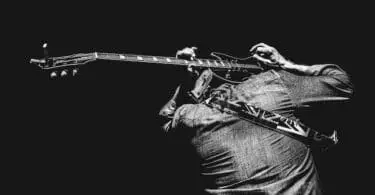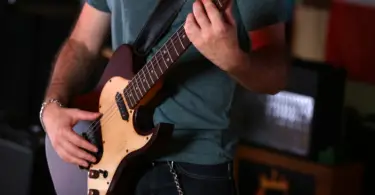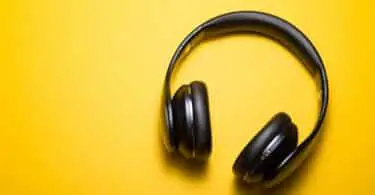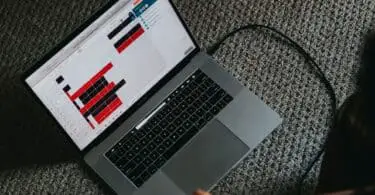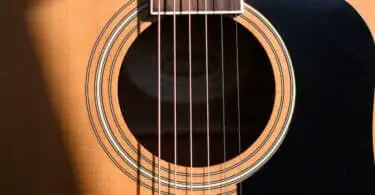A person who has decided to learn how to play guitar for the first time will find it difficult to begin without proper guidance. You might need someone to teach you how to do so, someone who can give you tips or show you routines to follow. But, to learn how to play guitar fast, you have to be consistent with your playing routine and commit your time to practice.
Your willingness to learn can help you to improve playing the guitar or any instrument you want. Knowing what to practice on your guitar along with the basic knowledge on your guitar’s parts and functions will allow you to proceed with practicing and developing your skills through this guide.
As you read this article, you will get a list of what to practice on guitar. This list can help you get started on your guitar-playing journey. So, let’s get started!
Quick Links
1. Learn The Music Slowly
As you start to play your guitar, you will make mistakes but take it slowly. This will allow you to have more muscle memory.
Slowing down can help you to learn new pieces and music on an advanced level. Taking your time gradually will speed up your skills in practicing on a guitar.
2. Practice Using A Metronome
Practicing guitar with a metronome is necessary to train you to play in time and beat. Using a metronome is helpful with playing guitar and other instruments such as ensembles and drums.
3. Learn The Basic Tunes
To learn how to play guitar, start by playing the easiest and simplest tunes or melodies. You can learn them when you know how to read some guitar tabs.
However, learning to play these tunes by reading guitar tabs will make your fingers hurt. But this routine will develop muscle memory if you keep on playing.
Meanwhile, other guitar players stretch their fingers using the guitar neck. They try to extend their fingers in the guitar neck as a warm-up exercise, allowing them to be more flexible and easily make quicker and more awkward movements on the guitar’s neck.
4. Changing Chords From One To Another
Learn to change chords slowly and gradually. Try to match guitar chords up to eight different chords, and you will eventually play a song.
Do this a couple of times for you to master how to change chords from one to another. Changing chords slowly improves your muscle memory, especially the movement of your fingers and hand.
5. Learning To Read Guitar Tabs
One good idea to introduce to a first-time guitar player is to read guitar tabs. Learning to read guitar tabs is simpler and easier than learning to read the standard music notations. You can easily understand the standard music notation when you already know how to read guitar tabs.
6. Sing The Melodic Lines
Try to sing when playing your guitar. You can easily change and memorize a chord when you accompany your playing with singing. Also, it can help you to learn more tunes and melodies.
7. Train Your Hand Movements
Practice your left and right hand movements to build and create coordination. You can practice it by doing it separately to get used to it and combine them as you play your guitar.
8. Chords In Different Positions
Suppose you are already familiar with some basic open guitar chords. You may try playing chords in multiple positions on the fretboard.
Play barre chords for new shapes and positions of chords down to the guitar neck. You can test how many ways you can play the same chords by changing them in different positions.
9. Learn To Pick, Strum And Pluck
person playing electric guitar photo – Free Guitar Image on Unsplash
If your left hand is already trained with changing chords, your right hand must also be trained to play. Learn how to strum with your right fingers to develop muscle memory. You may also learn how to pick and pluck guitar strings to hit the right tune and sounds.
10. Playing Major And Minor Chords
There are so-called open major and minor chords when playing guitar. These chords are way easier than those barre chords.
You should begin with learning to play major and minor chords such as C, G, A, E, D major, and Am, Em, and Dm minor. Some open major and minor chords are easily played, and you will have more choices and options to learn new songs and melodies.
11. Learn The Basic Music Theories
Aside from learning some basic chords and strumming, there is still work to be done, like learning music theory. These music theories will help you to connect all your routines and learning in playing guitar. Aside from learning to move around your fingers on the fretboard, you need to understand that there are more than the routine and movements to play guitar solos, licks, and riffs.
12. Practice Playing Harmonics
Playing guitar does not only focus on learning the chords. You must also learn some of the guitar techniques to diversify your music and songs.
You can try pull-offs, harmonics, muting, and hammer-ons. These guitar techniques will let you go beyond being a beginner guitar player.
13. Focus On Strumming Patterns
Learning more about how to strum a guitar will give you more options to play. The more guitar rhythm patterns you know, the more songs and melodies you will have.
Knowing some strumming techniques can also spice up your music. Even if you’re only a beginner, you can play new styles of music such as pop, rock, metal, and country.
Strumming patterns or techniques depend on your personal preference. You might also consider practicing playing your guitar by fingerpicking or flat-picking. It’s an excellent way to improve your strumming methods to develop versatility to discover new sounds.
14. Learn The Rhythm Techniques
Training to play with rhythm techniques is crucial, such as country, pop, and rock music. You may use your left hand to mute some of the guitar strings while playing rhythm patterns.
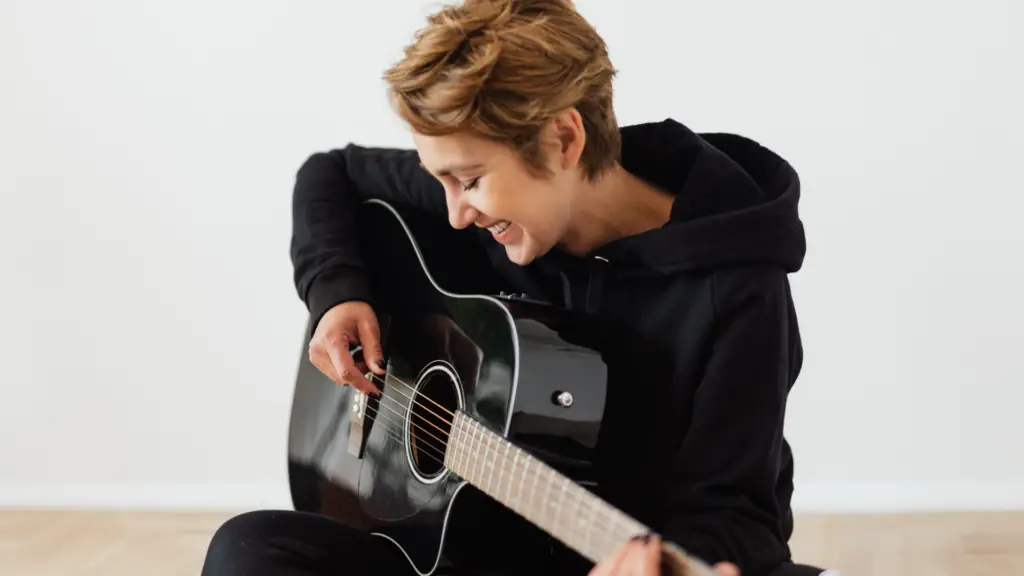
15. Practice How To Transpose
Knowing how to transpose the music to up and down is one of the keys that can help you learn intervals. Transposing is also important to train and practice your ears to determine the connection or relationship of the chords and notes.
16. Learn To Use Your Visualization Skills
Whenever you learn a new chord technique, always remember to visualize how it looks on the fretboard. Learn how the hand movements are placed on the fretboard for better memorizing the chord patterns. Do visualizations when playing passage music.
17. Practice To Play Songs
While building your muscle memory, you also get motivated when you learn some of the basic tunes and melodies needed to play a song. There are a lot of options to choose to play with your guitar. Knowing to strum and change chords will let you play more songs of your choice.
18. Start Playing Barre Chords
Barre chords are way difficult to practice and learn compared to open major and minor chords. You need to have more practice to have finger strength and agility to achieve those barre chords.
However, even if barre chords are difficult to follow and learn, many beginners can still manage to play, especially when they press harder on the guitar strings and improve the movements and positions of their fingers.
19. Practice Phrasing Techniques
For you to play two consecutive notes or chords, you must be able to pick both. This technique is called phrasing.
Phrasing techniques are applied to produce different styles of sounds from the same note. Examples are string bends and vibrato. Keep practicing to learn each phrasing technique to reinforce your basic guitar playing skills.
20. Play Guitar Licks And Riffs
As you learn and master the phrasing techniques, you can start building your knowledge about guitar licks and riffs. It is incorporated with a more difficult technique.

21. Practice Your First Scales
Guitar scales are needed to create music. Learning about guitar scales will help you play your guitar to the next level. You will be able to improvise tunes and sounds. You can improve your guitar scales by using them more often.
22. Learn Melodies With Different Speed
Try to experiment with songs or melodies with different speeds or tempos. Challenge yourself to play music with a slow to fast tempo. It will help you to practice hand movements and chord techniques. The slower the melody, the easier it is to play. However, when you change with faster tempos, you will be surprised that you can play more of this kind of melody.
23. Choose Songs That You Love
When you practice playing guitar, try to look for a song that you love listening to. It will help you memorize the chords and hand movements because you are already used to the tune and melody of the song. Always start with easy melodies for songs, and as you go along with practicing, you can also easily play hard types of music.
24. Work On Unfamiliar Songs
The easier the music, the easier you get used to it. But, working or practicing unfamiliar songs will bring out your skills and versatility to music.
You can play and create your own chord progression with songs or melodies you do not usually play. This way, you can learn a new style of music and develop your listening abilities to notes and sounds. Always start with a warm-up when playing guitar.
25. Eliminate Chord Pauses
Make sure to avoid pauses between chords. Each chord must come out with a clear tune and sounds. You can have chord progression exercises to improve your transitions.
A simple chord progression exercise is to strum each chord four times in a series. This type of exercise will be beneficial to keep the rhythm and tune in time to make it effective.
26. Learn How To Produce Dynamics
You can add life while playing your guitar by adding dynamics and dimension. It will give meaning and power to the produced tunes and sounds. Knowing how to learn dynamics will make it a regular part of your guitar playing.
Sound dynamics also include articulation like legato, accents, staccato. Articulation is about how you play guitar notes. Practice how the articulation works with your guitar exercises.
27. Try To Record
While you are practicing to play your guitar, record and critique yourself. Try to listen to your recording to get insights and to know your mistakes.
A phone or computer can be used to record your sounds. You can also use a looper pedal to record your produced sounds instantly. Recording can also help you improve your way of playing the guitar and discover new techniques to develop more skills from playing.
28. Technique On Timing
While you focus on chord progressions and techniques, consider the timing when you play your guitar. Timing is crucial when playing an instrument, and it is one of the things to focus on to produce better tunes and sounds.
Some Final Words
Practicing to play guitar more often can make you more confident when playing and have advanced knowledge of guitar playing techniques. This guide, along with the simple tips mentioned earlier, will let you move from being a beginner to becoming a professional guitar player.
Keeping up the work with playing your guitar can result in a significant impact on your guitar performances. The abovementioned tips should be part of your practice routines to get used to it and help you develop your skills faster. Skill development in guitar playing happens when you know your goals and when you push yourself to play comfortably.
With a basic guide on practicing how to play guitar, you can gradually adapt to challenges with chord exercises. Committing yourself to learn and practice playing the instrument will allow you to become better at playing your guitar.
If you want to have real progress, you might need to go beyond the basics to be advanced and be more than a beginner. To have a light and enjoyable time practicing, have fun while building proficiency and technique in playing guitar.

